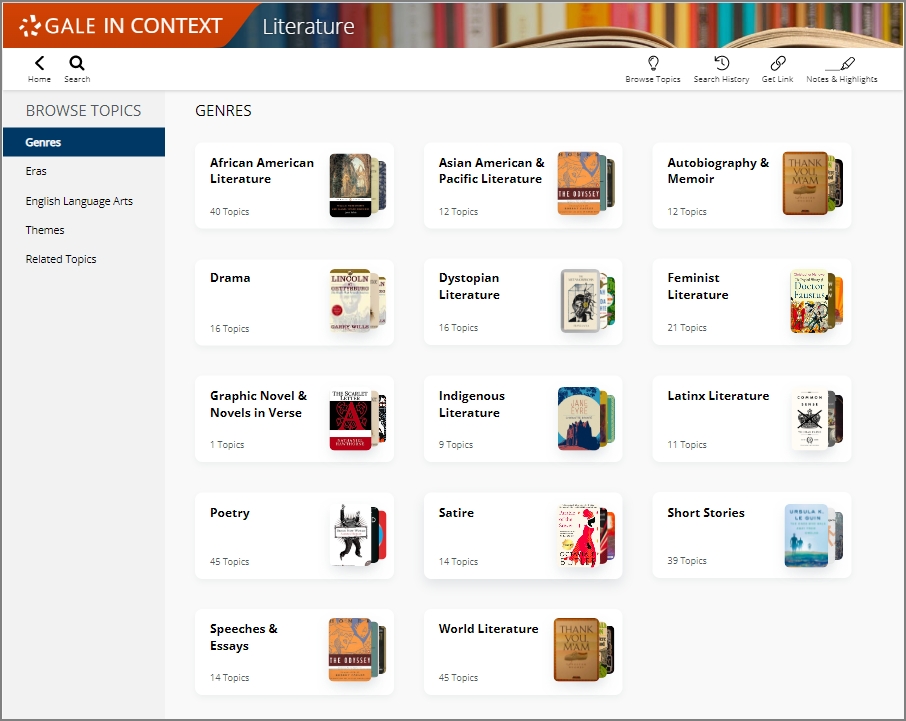| By: Sarah Klein |
As Gale’s K-12 curriculum design specialist, my role at its core is to bridge the content Gale creates with the subjects and standards that educators are seeking. It’s my job to identify the new topics and types of supplementary supports that Gale features across its numerous K-12 resources. I’m incredibly excited to announce that those resources are expanding to include the all-new Gale In Context: Literature.
As someone who taught high school English for many years, I’m champing at the bit to share everything there is to know about this new tool for English language arts (ELA) classes.
Understanding the Needs of English Teachers
When our team first decided to add a dedicated K-12 literature resource to the Gale In Context suite, we began from a place of reflection. My experience as a high school English teacher gave me a wealth of understanding to draw on to help shape this tool.
I taught high school English at every level, ranging from 9th grade ELA to AP literature and AP language—all in different environments, including a private religious school, large public school, and college-prep charter school. I led instruction in person, remotely, and even finagled my way through half a year of hybrid learning. I understand how driven educators are in the mission to support an ever-evolving student body.
When I was teaching, I went to half a dozen different websites every night to meet the diverse needs of my students and the requirements of my state standards. I utilized plot diagrams and character maps from one place and found text pairing suggestions from another. I gathered work overviews for my struggling learners, so they could familiarize themselves before diving into a new text. I combed through YouTube, searching for appropriate and engaging videos to kick-start my lessons. And I spent my commute to work listening to teacher and library podcasts, trying to glean new classroom management techniques and discover historically marginalized authors that I could introduce into my curriculum.
As an educator, I depended on all these tools and owed them a debt of gratitude. But I also believe in a growth mindset, and I had lots of ideas on how to improve and centralize those supplemental resources.
Arranging Relevant Literature Content in a Way That Makes Sense
Teaching experience from multiple members of our team heavily impacted the development of content in Gale In Context: Literature.
The new resource will feature infographics such as plot diagrams and character maps with detailed summaries and engaging visuals that will help support differentiation goals.
There are videos at the top of each portal page from teacher-trusted and student-approved sources, such as Crash Course, TED-Ed, and PBS Digital Studios. These curated videos will save educators from spending off-hours falling down YouTube rabbit holes in a valiant—yet exhausting—effort to incorporate more multimedia into lesson plans.
In collaboration with our brilliant content developers, we also created 300 new topic overviews for our literature portals, giving students at-a-glance insight into the bigger picture and putting works “in context” before they begin reading.
The work overviews in these portals highlight every element of fiction and explain the historical and contemporary context surrounding each story. The author overviews dig into their writing styles, their purpose, and their historical context. And the ELA term overviews help students identify the literary devices or rhetorical techniques they’re researching, while also providing instructions on how to implement those techniques in their own writing. All of these new overview documents can be leveraged in lesson plans to help target common core standards and support classroom instruction.

Adding Bookshelves into a Digital Literature Resource
But all of this matters only if students can find what they’re looking for. That’s why we created bookshelves.
The bookshelf browse path is our organizing principle in Gale In Context: Literature. It’s the method by which we grouped our ELA portals to guide students and teachers to the information they need. What I love most about the bookshelf browse is that it supports a variety of approaches. You can peruse books and authors by era, flipping through bookshelves organized by specific literary movements. This path will help ensure that you are featuring works from the literary periods that your state standards demand. You can also browse by genre and discover the vast variety of short stories available to you, or uncover a new graphic novel that you can introduce into your curriculum.
Additionally, you can search by theme, discovering bookshelves full of texts that share recurring ideas about identity, technology and society, fate versus free will, and all the other thematic classics we cover in an English classroom. Theme browse is designed specifically to help you identify works that pair well together.
There are also bookshelves that highlight historically marginalized communities. You will be able to unlock bookshelves full of portals on Asian American and Pacific Islander literature, Black literature, Indigenous literature, feminist literature, world literature, and more. These bookshelves will support your ongoing efforts to modernize your curriculum and help students see their diverse backgrounds and experiences reflected in the works they read.
Gale In Context: Literature does the work of curating a contemporary canon and creating new styles of supplementary support, so teachers can devote less time to tracking things down and more time focusing on the essential work of educating.
Ready for a closer look at Literature? Request a personalized walk-through with your education consultant.

About the Author
Sarah is an educator and curriculum design specialist. When she’s not busy reading, Sarah typically spends her time listening to library podcasts and baking for friends and family.

